Year after year, the cost of electricity increases in all Latin American countries, and when the accounts of the power reach the producers and small entrepreneurs, inevitably it points to something to blame: refrigeration systems.
The requirements needed to carry out an adequate cooling, pre-cooling and freeze-up production process absorb up to 80% of electrical energy. So, if your production depends on cooling processes ... you know better than we do what a bad system costs you.
What is energy efficiency in refrigeration systems?
Each refrigeration system responds to the particular conditions of the project and uses different equipment and refrigerant gases to reach and maintain the proper temperature. The energy efficiency of your system is determined by two factors:
- Refrigerating power: That’s, the amount of "cold to produce", or to put it correctly, the amount of heat that we want to extract from an environment.
- Energy power: It’s defined by the amount of energy injected to reach the ideal temperature.
An efficient cooling system must guarantee the highest refrigerating power with the lowest power possible.
It seems easy, but how is it achieved? There are many factors to consider in order for the knowledge of a refrigeration engineer to translate to a lower power bill.
Choose the most suitable cooling system for your industry
It’s not the same to cool tons of smooth cayenne pineapple than a pharmaceutical laboratory or a meat handling channel. Although there are cooling systems with a high energy efficiency, this doesn’t mean that they’re the best for your industry. Among the most well-known refrigeration systems, we can find:
- Forced air
- Vacuum cooling
- Ice cooling
- Water cooling
Your choice depends on the conditions of your production and only after an evaluation, the consultant will agree on the best system for your industry.
Climate and geographical conditions affect energy efficiency
An efficient cooling system for a dry climate can be disastrous for humid environments, and variations are triggered if we consider the annual average temperature, the change between seasons and how exposed to the environment your refrigeration equipment will be.
The design of your cooling system will make the difference in your energy bill
How many digits do you want your next bill or electricity receipt to have? Think about it before you check prices of a refrigeration equipment. A good design of your cooling system should solve both your production needs and your electricity expenditure. Among other things, refrigeration engineers will guide you on:
Installation conditions
The equipment should be located in cool places, or consider variants of sun exposure. It’s important that the walls and ceilings have light colors to reduce the heat of the installations.
Choosing of refrigerants
In recent years we’ve seen a strong debate on the environmental impact of refrigerants, and your company should be part of that debate. Alternatives such as CO2 and ammonia not only reduce atmospheric damage but can also help increase the energy efficiency of your system.
When choosing a refrigerant, your refrigeration consultant should consider the current laws in your country and safety factors such as discharge gas temperature and toxicity or risk of inflammation.
Choosing a refrigerant is extremely complex and its performance in your refrigeration system will help you to reduce costs not only of energy but other supplies.
Related
Discover more related articles

Air-cooled chiller and water-cooled chiller: What are the differences
Choosing and installing a refrigeration equipment can be a headache if you don’t have enough information about its features and applications. Having...
Read more »
Air-cooled chiller or water-cooled chiller: preparing a cost proposal
We have previously raised the difference between these systems because of the better heat transfer properties of water compared to air-cooled...
Read more »
